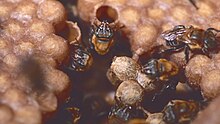Melipona bicolor
| Melipona bicolor | |
|---|---|
 |
|
| M. bicolor workers in nest | |
| Scientific classification | |
| Kingdom: | Animalia |
| Phylum: | Arthropoda |
| Class: | Insecta |
| Order: | Hymenoptera |
| Family: | Apidae |
| Subfamily: | Apinae |
| Tribe: | Meliponini |
| Genus: | Melipona |
| Species: | M. bicolor |
| Binomial name | |
|
Melipona bicolor Lepeletier, 1836 |
|
Melipona bicolor (Lepeletier, 1836), commonly known as Guaraipo or Guarupu, is a eusocial bee found primarily in South America. It is an inhabitant of the Araucaria Forest and the Atlantic Rainforest, and is most commonly found from South to East Brazil, Argentina, and Paraguay. It prefers to nest close to the soil, in hollowed trunks or roots of trees.M. bicolor is a member of the tribe Meliponini, and is therefore a stingless bee. This species is unique among the stingless bees species because it is polygynous, which is rare for eusocial bees.
M. bicolor belongs to the genus Melipona and the tribe Meliponini, which comprises about 500 species of stingless bees. Although they are called stingless, these bees do have a stinger, but it is extremely small and cannot be used for defense.M. bicolor is closely related to the other 40 known species in the genus Melipona.
M. bicolor is about 8 to 9mm long and have a stocky body. Coloration can vary from yellow to dark yellow. The males have either black or green eyes.
As with all Melipona species, M. bicolor build well-protected nests inside pre-existing cavities. Their nests typically have a single entrance, which is long and narrow and penetrates deep into the nest. The nest cavity consists of two parts: a well-developed involucrum, surrounding a nest consisting of several layers of horizontally arranged combs, and outside the involucrum, which house a number of food pots. A significant amount of food can be stored in these pollen and honey pots. The pots can be large, getting as big as 4 cm in diameter. The pots sizes do vary with the state of the colony however.
...
Wikipedia
